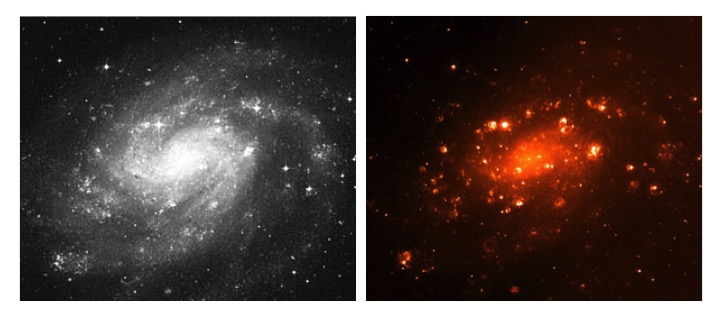Star Formation
The MOSDEF collaboration is interested in understanding how galaxies evolve, or change with time. And one of the most important ways galaxies evolve is by converting their gas into stars.
Using images of galaxies, it is not too difficult to determine the approximate number of stars in them. Basically, we have to assume that a certain amount of light is emitted for a given amount of stars (or what astronomers refer to as a “mass-to-light” ratio). If we add up all the light from an entire galaxy, that can give us the approximate number (or mass) of stars. This is especially true if we look at light that is visible to our eye.
But what we are particularly interested in is the rate of change in the amount of stars with time. Is that galaxy adding stars rapidly, or has it completed its star formation and is no longer evolving? But, as with much of astronomy, the time it takes for anything to change is much longer than our lifetimes, so we can’t just watch the galaxy change. So how do we know if new stars are forming, and how can we measure the rate of star formation precisely?
To understand how we do this, you must first know a little about stars. When a group of new stars is formed, they come in a wide variety of masses. Most of the stars are smaller than the Sun, but some of them are huge, with masses more than 20 times the mass of the Sun. These massive stars don’t live very long, only a few million years (which is a very short amount of time compared to the billions of years it takes a galaxy to form). But while they’re alive, they emit a large amount of light, and much of that light is very energetic, in the ultraviolet part of the spectrum. The lower mass stars, however, don’t emit any of this ultraviolet light, but can live for billions of years.
So, if you can see this ultraviolet light being emitted from a galaxy, it indicates that stars have formed very recently (unless there is an active supermassive black hole) and the amount of ultraviolet light tells us the number of stars.
Unfortunately, the vast majority of this ultraviolet light is absorbed by gas and dust inside the galaxy, and never makes it to our telescopes, making it very difficult to get an accurate determination of the star formation rate.

Fortunately, there is still a way to determine how much of this ultraviolet light has been emitted. When the most energetic ultraviolet light is absorbed by Hydrogen, it ionizes it, freeing an electron from the nucleus of the atom and sending it off into the gas cloud. When the electron finds another nucleus, it “recombines” and emits light at specific wavelengths as the electron settles back into the lowest energy configuration. Some of these “emission lines” are emitted in the visible part of the spectrum and can be seen by the MOSDEF data for galaxies in the early universe. We can measure how bright the galaxy in these emission lines and determine the rate that Hydrogen is recombining. This gives us the rate at which the Hydrogen is being ionized, which gives us the rate that stars emit these photons, which ultimately gives us the number of massive stars. And if we know these massive stars could have only formed in the past ~5 million years, we can divide the number of stars by the number of years to get the approximate rate that stars are forming in the galaxy.
Of course, this calculation makes a number of assumptions and requires corrections. First, we assume that the ratio of massive stars to total stars is the same everywhere. Second, we assume that all of the ultraviolet light that is capable of ionizing Hydrogen does so, and doesn’t escape the galaxy. And finally, we have to correct the luminosity of these emission lines for extinction by dust. Nonetheless, it’s pretty cool that with a few quick measurements we can determine if a galaxy is forming stars very quickly, or if it is “quiescent” — not forming stars at all.